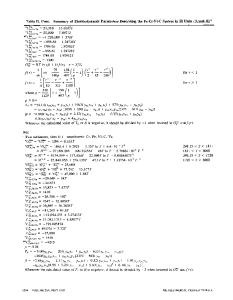Thermodynamic assessment of the Al-Zr binary system
- PDF / 117,075 Bytes
- 8 Pages / 612 x 792 pts (letter) Page_size
- 88 Downloads / 417 Views
Thermodynamic Assessment of the Al-Zr Binary System Tao Wang, Zhanpeng Jin, and Ji-Cheng Zhao
(Submitted 18 December 2000; in revised form 12 June 2001) The thermodynamic parameters of the Al-Zr binary system can be very useful for the development of Zr-Al based amorphous and nanocrystalline materials. Phase diagram and thermochemistry data, especially the enthalpy of mixing of the liquid phase and the standard enthalpy of formation for the intermetallic compounds, are employed to optimize a consistent thermodynamic description for all the phases. The liquid, fcc, bcc, and hcp phases are treated as disordered solutions, while all the intermetallic phases are taken as stoichiometric compounds. The calculated phase diagram and thermochemistry data agree well with most of the experimental values reported in the literature.
1. Introduction Zr-Al based amorphous and nanocrystalline alloys have recently attracted attention because of their high strength, high ductility, and high glass-forming ability.[1,2] A thermodynamic assessment of the Al-Zr binary system may be used as a base for building a thermodynamic database for higher order systems of glass-forming alloys. In addition, this binary system is part of our effort to perform a thermodynamic assessment of the Ni-Al-Zr ternary system in order to add Zr into the existing Ni database[3] for predicting phase stability in Ni-base superalloys. Although Saunders and Rivlin[4,5] have already performed an assessment of the Al-Zr system, their assessment did not include the Zr4Al3 phase. In addition, new experimental results on the Zr-rich part of the phase diagram resulted in a revision of some invariant reaction temperatures by as much as 40 ⬚C.[6] Recent data on the enthalpies of formation for some of the intermetallic compounds[7,8] are also significantly different from the thermodynamic assessment of Saunders and Rivlin.[4,5] It is therefore necessary to reassess the thermodynamic parameters of the Al-Zr binary system to be consistent with the new experimental data.
2. Review of Experimental Data
incipient melting, and thermal analysis. The phase diagram proposed by Murray et al.[9] was mainly based on this investigation. Peruzzi[6] redetermined the Zr-rich part of the phase diagram in the range 500 to 1300 ⬚C by means of metallography, XRD, electron microprobe analysis, and electrical resistance measurement. In the present thermodynamic assessment, the results from Peruzzi were used for the Zrrich part of the phase diagram, because the samples used by Peruzzi had higher purity than those used in the previous experimental study.[11] Several investigations[6,11–14] were performed on the solid solubility of Al in Zr, and the results roughly agree. No experimental information could be found concerning the two-phase L ⫹ bcc(Zr) field or the hcp(Zr) ⫹ bcc(Zr) field. The Al-rich side of the phase diagram up to 1000 ⬚C was determined by Fink and Willey,[15] Glazov et al.,[16] Drits et al.,[17] Kuznetsov et al.,[18] and Chiotti and Woerner.[19] The results are in good agreem
Data Loading...











